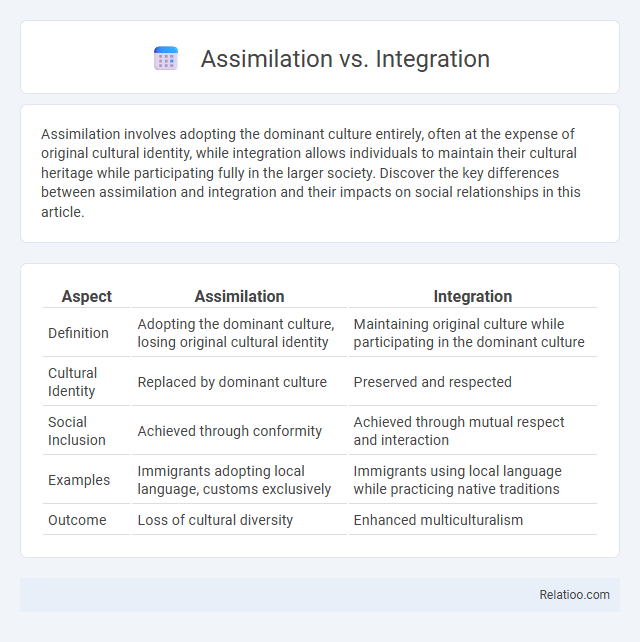Assimilation involves adopting the dominant culture entirely, often at the expense of original cultural identity, while integration allows individuals to maintain their cultural heritage while participating fully in the larger society. Discover the key differences between assimilation and integration and their impacts on social relationships in this article.
Table of Comparison
| Aspect | Assimilation | Integration |
|---|---|---|
| Definition | Adopting the dominant culture, losing original cultural identity | Maintaining original culture while participating in the dominant culture |
| Cultural Identity | Replaced by dominant culture | Preserved and respected |
| Social Inclusion | Achieved through conformity | Achieved through mutual respect and interaction |
| Examples | Immigrants adopting local language, customs exclusively | Immigrants using local language while practicing native traditions |
| Outcome | Loss of cultural diversity | Enhanced multiculturalism |
Understanding Assimilation and Integration
Assimilation involves individuals or groups fully adopting the cultural norms and values of a dominant society, often leading to the loss of their original cultural identity. Integration allows for coexistence where individuals maintain their unique cultural identities while participating fully in the social, economic, and political life of the host society. Understanding assimilation and integration highlights the balance between cultural adaptation and cultural preservation within multicultural settings.
Historical Contexts of Assimilation and Integration
Assimilation historically involved minority groups adopting the dominant culture, often enforced through policies like the U.S. Indian Boarding Schools aimed at erasing Indigenous identities. Integration emerged as a more inclusive approach, promoting the coexistence of diverse cultures within society, notably seen in post-apartheid South Africa's efforts to unify racial groups while respecting cultural differences. Your understanding of these concepts highlights the evolving nature of cultural adaptation, shaped by historical attempts to balance unity and diversity.
Key Differences Between Assimilation and Integration
Assimilation involves individuals or groups fully adopting the cultural norms and values of the dominant society, often leading to the loss of their original cultural identity. Integration allows for the coexistence of multiple cultures where individuals retain their unique cultural traits while participating equally in the larger society. Key differences between assimilation and integration include the degree of cultural retention and the emphasis on maintaining diversity versus promoting cultural uniformity.
Social Impacts of Assimilation
Assimilation often leads to significant social impacts by encouraging individuals or groups to adopt the dominant culture's norms and values, which can result in the loss of original cultural identity and heritage. Your social connections may shift as assimilation pressures create a homogenized community, potentially reducing cultural diversity and weakening social cohesion among minority groups. Understanding these social consequences is crucial for fostering inclusive policies that balance cultural preservation with societal integration.
Cultural Effects of Integration
Integration fosters cultural exchange and mutual respect, enabling Your community to retain unique identities while participating in a shared society. Unlike assimilation, integration encourages adaptation without erasing original cultural traits, promoting diversity and social cohesion. The cultural effects of integration include enhanced social inclusion, reduced prejudice, and the creation of multicultural environments where different traditions coexist and enrich one another.
Policy Approaches: Assimilation vs Integration
Assimilation policies require immigrants to adopt the dominant culture's language, values, and norms, often at the expense of their original cultural identities. Integration policies promote social inclusion while allowing immigrants to maintain their cultural heritage, supporting multiculturalism and reciprocal adaptation. Your choice between these approaches shapes how diverse communities coexist and ensures equitable access to social, economic, and political opportunities.
Challenges in Implementing Assimilation
Assimilation often faces challenges including loss of cultural identity, resistance from minority groups, and social alienation within host societies. The process demands significant behavioral and cultural adaptation that can lead to psychological stress and hinder social cohesion. Policy enforcement may also encounter ethical concerns and public opposition when forced conformity undermines multicultural values.
Benefits of Successful Integration
Successful integration fosters social cohesion by allowing individuals to maintain their cultural identity while actively participating in the broader society, enhancing mutual understanding and respect. Your community benefits from increased economic opportunities and reduced social tensions when diverse groups are included and valued in social, educational, and professional settings. Integration also promotes mental well-being by creating supportive environments where people feel recognized and empowered to contribute meaningfully.
Case Studies: Assimilation and Integration in Practice
Case studies of assimilation highlight examples where minority groups fully adopt the dominant culture's language, customs, and values, often losing their original cultural identity, such as Native American children in boarding schools. Integration case studies demonstrate successful coexistence of diverse cultures through policies promoting equal opportunities while preserving distinct cultural identities, as seen in Canada's multiculturalism approach. Your understanding of these processes can be enhanced by analyzing how different societies balance cultural retention and social inclusion in practice.
Future Perspectives on Assimilation and Integration
Future perspectives on assimilation emphasize a shift towards more inclusive models that respect multicultural identities while promoting social cohesion. Integration strategies increasingly focus on equitable access to education, employment, and political participation to foster belonging without erasing cultural heritage. Research highlights the importance of policy frameworks that support bi-cultural competencies, enabling individuals to navigate multiple cultural contexts effectively.

Infographic: Assimilation vs Integration
 relatioo.com
relatioo.com